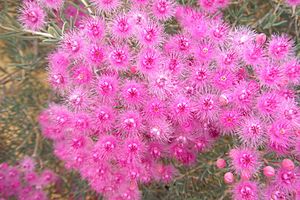Pink Morrison facts for kids
Quick facts for kids Pink Morrison |
|
|---|---|
 |
|
| V. monadelpha var. callitricha | |
| Scientific classification | |
| Genus: |
Verticordia
|
| Species: |
monadelpha
|
Verticordia monadelpha is a beautiful flowering plant that belongs to the myrtle family called Myrtaceae. It is found only in the south-west part of Western Australia. This plant is a bushy shrub with many branches. It produces lovely pink to magenta flowers during spring and early summer.
People often call it by several names, like pink Morrison, woolly featherflower, pink woolly featherflower, white woolly featherflower, or pink cauliflower.
Contents
What Does it Look Like?
Verticordia monadelpha is a dense, rounded shrub. It usually grows about 1.7 to 2.0 meters (5.6 to 6.6 feet) tall. It has many branches coming from a single main stem.
Its leaves are thin and pointed, measuring about 7 to 20 millimeters (0.3 to 0.8 inches) long. They have a sharp, triangular shape with ridges. The leaves near the flowers look similar to the ones on the stem.
From October to January, this plant blooms with many pink to reddish-purple flowers. These flowers grow close together and stand upright, covering the whole shrub. Each flower has long, hair-like fringes called cilia. These cilia give the plant a soft, woolly look.
How it Got its Name
Verticordia monadelpha was first officially described in 1847. A scientist named Nikolai Turczaninow gave it its name. He studied a plant sample collected by James Drummond in the 1840s.
The second part of its name, monadelpha, comes from two old Ancient Greek words. Monos means "one" and adelphos means "brother." This name refers to how the stamens (the male parts of the flower) are joined together.
In 1991, a scientist named Alex George studied the Verticordia group of plants. He identified two different types, or varieties, of Verticordia monadelpha. These are Verticordia monadelpha var. monadelpha and Verticordia monadelpha var. callitricha. The monadelpha variety is based on the original plant described by Turczaninow.
Another scientist, Carl Meissner, first described Verticordia callitricha in 1857. He used a sample collected by Drummond. Later, Alex George decided that Verticordia callitricha was actually a variety of V. monadelpha. This variety, callitricha, is usually smaller. It grows about 0.3 to 0.6 meters (1.0 to 2.0 feet) high and 0.4 to 0.75 meters (1.3 to 2.5 feet) wide. Sometimes, it can grow up to 1.3 meters (4.3 feet) tall.
Where it Grows
The monadelpha variety of Verticordia monadelpha likes to grow in deep sand, gravelly sand, and lateritic soils. You can often find it with other Verticordia plants in heathlands and shrublands northeast of Perth. This type is found in more places than the callitricha variety. It grows in the Avon Wheatbelt and Geraldton Sandplains areas of Western Australia.
The callitricha variety grows in deep sand or gravelly sand over laterite. It prefers heathlands and open shrubland. You might find it growing near plants like Actinstrobus arenarius and Banksia sceptrum. This variety is found in a smaller area, north of Geraldton and south of the Emu Proof Fence. It grows in Kalbarri National Park and extends south-east towards Morawa.
Protecting the Plant
In the past, Verticordia monadelpha plants were sometimes collected too much for their cut flowers. However, now they are protected by laws that stop people from picking wildflowers.
The common monadelpha variety can be affected by changes in how land is used and by different fire patterns. The callitricha variety, even though it's less common, is protected inside a National Park. Both varieties are currently considered "not threatened" by the Government of Western Australia's Department of Parks and Wildlife.
Growing it in Gardens
Both types of V. monadelpha have been successfully grown in gardens. This includes gardens in Western Australia and other states. The callitricha variety is often preferred because it forms bright, unusual mounds of color. However, it needs to be grown in places with low humidity (not too much moisture in the air).
Images for kids


